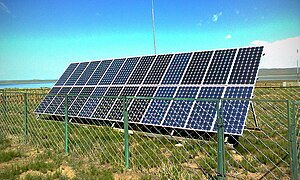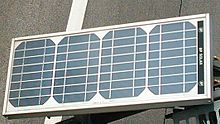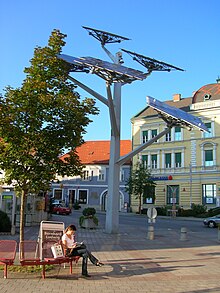This is an old revision of this page, as edited by ClueBot NG (talk | contribs) at 17:26, 16 March 2012 (Reverting possible vandalism by 98.114.46.220 to version by Tgeairn. False positive? Report it. Thanks, ClueBot NG. (959136) (Bot)). The present address (URL) is a permanent link to this revision, which may differ significantly from the current revision.
Revision as of 17:26, 16 March 2012 by ClueBot NG (talk | contribs) (Reverting possible vandalism by 98.114.46.220 to version by Tgeairn. False positive? Report it. Thanks, ClueBot NG. (959136) (Bot))(diff) ← Previous revision | Latest revision (diff) | Newer revision → (diff) "Photovoltaic module" redirects here. For For the heat collectors, see Solar thermal collector, see Photovoltaic module (disambiguation).


A solar panel (also solar module, photovoltaic module or photovoltaic panel) is a packaged, connected assembly of photovoltaic cells. The solar panel can be used as a component of a larger photovoltaic system to generate and supply electricity in commercial and residential applications.
Because a single solar panel can produce only a limited amount of power, many installations contain several panels. A photovoltaic system typically includes an array of solar panels, an inverter, and sometimes a battery and interconnection wiring.
Theory and construction
See also: Solar cell
Solar panels use light energy (photons) from the sun to generate electricity through the photovoltaic effect. The structural (load carrying) member of a module can either be the top layer or the back layer. The majority of modules use wafer-based crystalline silicon cells or thin-film cells based on cadmium telluride or silicon. The conducting wires that take the current off the panels may contain silver, copper or other non-magnetic conductive transition metals.
The cells must be connected electrically to one another and to the rest of the system. Cells must also be protected from mechanical damage and moisture. Most solar panels are rigid, but semi-flexible ones are available, based on thin-film cells.
Electrical connections are made in series to achieve a desired output voltage and/or in parallel to provide a desired current capability.
Separate diodes may be needed to avoid reverse currents, in case of partial or total shading, and at night. The p-n junctions of mono-crystalline silicon cells may have adequate reverse current characteristics that these are not necessary. Reverse currents waste power and can also lead to overheating of shaded cells. Solar cells become less efficient at higher temperatures and installers try to provide good ventilation behind solar panels.
Some recent solar panel designs include concentrators in which light is focused by lenses or mirrors onto an array of smaller cells. This enables the use of cells with a high cost per unit area (such as gallium arsenide) in a cost-effective way.
Depending on construction, photovoltaic panels can produce electricity from a range of frequencies of light, but usually cannot cover the entire solar range (specifically, ultraviolet, infrared and low or diffused light). Hence much of the incident sunlight energy is wasted by solar panels, and they can give far higher efficiencies if illuminated with monochromatic light. Therefore, another design concept is to split the light into different wavelength ranges and direct the beams onto different cells tuned to those ranges. This has been projected to be capable of raising efficiency by 50%.
Currently the best achieved sunlight conversion rate (solar panel efficiency) is around 21% in commercial products, typically lower than the efficiencies of their cells in isolation. The energy density of a solar panel is the efficiency described in terms of peak power output per unit of surface area, commonly expressed in units of watts per square foot (W/ft). The most efficient mass-produced solar panels have energy density values of greater than 13 W/ft (140 W/m).
Crystalline silicon modules
Main article: Solar cellMost solar modules are currently produced from silicon photovoltaic cells. These are typically categorized as monocrystalline or polycrystalline modules.
Thin-film modules
Main articles: Thin film solar cell, Third generation solar cell, and Low-cost photovoltaic cellThird generation solar cells are advanced thin-film cells. They produce high-efficiency conversion at low cost.
Rigid thin-film modules
In rigid thin film modules, the cell and the module are manufactured in the same production line.
The cell is created on a glass substrate or superstrate, and the electrical connections are created in situ, a so called "monolithic integration". The substrate or superstrate is laminated with an encapsulant to a front or back sheet, usually another sheet of glass.
The main cell technologies in this category are CdTe, or a-Si, or a-Si+uc-Si tandem, or CIGS (or variant). Amorphous silicon has a sunlight conversion rate of 6-12%.
Flexible thin-film modules
Flexible thin film cells and modules are created on the same production line by depositing the photoactive layer and other necessary layers on a flexible substrate.
If the substrate is an insulator (e.g. polyester or polyimide film) then monolithic integration can be used.
If it is a conductor then another technique for electrical connection must be used.
The cells are assembled into modules by laminating them to a transparent colourless fluoropolymer on the front side (typically ETFE or FEP) and a polymer suitable for bonding to the final substrate on the other side. The only commercially available (in MW quantities) flexible module uses amorphous silicon triple junction (from Unisolar).
So-called inverted metamorphic (IMM) multijunction solar cells made on compound-semiconductor technology are just becoming commercialized in July 2008. The University of Michigan's solar car that won the North American Solar Challenge in July 2008 used IMM thin-film flexible solar cells.
The requirements for residential and commercial are different in that the residential needs are simple and can be packaged so that as solar cell technology progresses, the other base line equipment such as the battery, inverter and voltage sensing transfer switch still need to be compacted and unitized for residential use. Commercial use, depending on the size of the service will be limited in the photovoltaic cell arena, and more complex parabolic reflectors and solar concentrators are becoming the dominant technology.
The global flexible and thin-film photovoltaic (PV) market, despite caution in the overall PV industry, is expected to experience a CAGR of over 35% to 2019, surpassing 32 GW according to a major new study by IntertechPira.
Module embedded electronics
See also: Solar micro-inverterSeveral companies have begun embedding electronics into PV modules. This enables performing maximum power point tracking (MPPT) for each module individually, and the measurement of performance data for monitoring and fault detection at module level. Some of these solutions make use of power optimizers, a DC-to-DC converter technology developed to maximize the power harvest from solar photovoltaic systems. As of about 2010, such electronics can also compensate for shading effects, wherein a shadow falling across a section of a panel causes the electrical output of one or more strings of cells in the panel to fall to zero, but not having the output of the entire panel fall to zero.
Module performance and lifetime
Module performance is generally rated under standard test conditions (STC): irradiance of 1,000 W/m², solar spectrum of AM 1.5 and module temperature at 25°C.
Electrical characteristics include nominal power (PMAX, measured in W), open circuit voltage (VOC), short circuit current (ISC, measured in amperes), maximum power voltage (VMPP), maximum power current (IMPP), peak power, kWp, and module efficiency (%).
Nominal voltage refers to the voltage of the battery that the module is best suited to charge; this is a leftover term from the days when solar panels were used only to charge batteries. The actual voltage output of the panel changes as lighting, temperature and load conditions change, so there is never one specific voltage at which the panel operates. Nominal voltage allows users, at a glance, to make sure the panel is compatible with a given system.
Open circuit voltage or VOC is the maximum voltage that the panel can produce when not connected to an electrical circuit or system. VOC can be measured with a meter directly on an illuminated panel's terminals or on its disconnected cable.
The peak power rating, kWp, is the maximum output according under standard test conditions (not the maximum possible output).
Solar panels must withstand heat, cold, rain and hail for many years. Many crystalline silicon module manufacturers offer a warranty that guarantees electrical production for 10 years at 90% of rated power output and 25 years at 80%.
Production

In 2010, 15.9 GW of solar PV system installations were completed, with solar PV pricing survey and market research company PVinsights reporting growth of 117.8% in solar PV installation on a year-on-year basis. With over 100% year-on-year growth in PV system installation, PV module makers dramatically increased their shipments of solar panels in 2010. They actively expanded their capacity and turned themselves into gigawatt GW players. According to PVinsights, five of the top ten PV module companies in 2010 are GW players. Suntech, First Solar, Sharp, Yingli and Trina Solar are GW producers now, and most of them doubled their shipments in 2010.
Top ten producers
The top ten solar panel producers (by MW shipments) in 2010 were:
- Suntech
- First Solar
- Sharp Solar
- Yingli
- Trina Solar
- Canadian Solar
- Hanwha Solarone
- Sunpower
- Renewable Energy Corporation
- Solarworld
Price
See also: Grid parityAverage pricing information divides in three pricing categories: those buying small quantities (modules of all sizes in the kilowatt range annually), mid-range buyers (typically up to 10 MWp annually), and large quantity buyers (self explanatory—and with access to the lowest prices). Over the long term—and only in the long-term—there is clearly a systematic reduction in the price of cells and modules. For example in 1998 it was estimated that the quantity cost per watt was about $4.50, which was 33 times lower than the cost in 1970 of $150.
Following to RMI, Balance-of-System (BoS) elements, this is, non-module cost of non-microinverter solar panels (as wiring, converters, racking systems and various components) make up about half of the total costs of installations. Also, standardizing technologies could encourage greater adoption of solar panels and, in turn, economies of scale.
Mounting systems
Trackers
Solar trackers increase the amount of energy produced per panel at a cost of mechanical complexity and need for maintenance. They sense the direction of the Sun and tilt the panels as needed for maximum exposure to the light.
Fixed racks
Fixed racks hold panels stationary as the sun moves across the sky. The fixed rack sets the angle at which the panel is held. Tilt angles equivalent to an installation's latitude are common.
Ground mounted
Ground mounted solar power systems consist of solar panels held in place by racks or frames that are attached to ground based mounting supports.
Ground based mounting supports include:
- Pole mounts, which are driven directly into the ground or embedded in concrete.
- Foundation mounts, such as concrete slabs or poured footings
- Ballasted footing mounts, such as concrete or steel bases that use weight to secure the solar panel system in position and do not require ground penetration. This type of mounting system allows for decommissioning or relocation of solar panel systems with no ground excavation.
Roof mounted
Roof mounted solar power systems consist of solar panels held in place by racks or frames attached to roof based mounting supports.
Roof based mounting supports include:
- Pole mounts, which are attached directly to the roof structure and may use additional rails for attaching the panel racking or frames.
- Ballasted footing mounts, such as concrete or steel bases that use weight to secure the panel system in position and do not require through penetration. This mounting method allows for decommissioning or relocation of solar panel systems with no adverse effect on the roof structure.
 |
 |
Standards
Standards generally used in photovoltaic panels:
- IEC 61215 (crystalline silicon performance), 61646 (thin film performance) and 61730 (all modules, safety)
- ISO 9488 Solar energy—Vocabulary.
- UL 1703
- UL 1741
- CE mark
- Electrical Safety Tester (EST) Series (EST-460, EST-22V, EST-22H, EST-110).
Devices with photovoltaic modules
Further information: Solar panels on spacecraft and Solar chargerElectric devices that includes solar panels:
- Solar cell phone : Sharp announced that its first solar-powered cell phone would be released in summer, 2009.
- Solar lamp
- Solar notebook: IUNIKA makes the first Solar Powered Netbook, the Gyy.
- Solar-pumped laser
- Solar vehicle
- Solar plane
Space stations and various spacecraft employ, or have employed photovoltaic panels to generate power.
- Soyuz spacecraft
- International Space Station
- Skylab space laboratory
- Mir space station
| This section needs expansion. You can help by adding to it. (December 2009) |
See also
- Building-integrated photovoltaic (BIPV).
- Cleaning event (Mars Exploration Rover phenomenon)
- Distributed inverter architecture
- Domestic energy consumption; supplies energy requirement numbers for private homes which is needed for anyone thinking of installing their own PV solar panels
- Insulated glazing
- Moore's Law
- Photovoltaics e.g. applications
- Photovoltaic system
- List of photovoltaics companies
- Sky footage
- Smart grid
- Solar roadway
- Superstrate
- UV degradation
- Solar pond
- Solar Module Quality Assurance
References
- "Diodes". Kpsec.freeuk.com. Retrieved 2010-10-18.
- STO: Very High Efficient Solar Cells
- "World's most efficient solar panel". The Independent. 2011-06-26.
- "Global flexible and thin-film PV market expected to reach US$58b in 2019,reports by IntertechPira study". Globalsolartechnology. 2009-09-11.
- "Introduction to Solar Electricity and Residential Solar Panels – AltE". altestore.com. Retrieved September 3, 2010.
- "CTI Solar sales brochure" (PDF). cti-solar.com. Retrieved September 3, 2010.
- ^ "PVinsights announces worldwide 2010 top 10 ranking of PV module makers". www.pvinsights.com. Retrieved 2011-05-06.
- Harnessing Light. National Research Council. 1998. p. 162.
- Paula Mints (24 September 2009). "Module Pricing: Rational, Or Just Plain Nuts?". Photovoltaics World Magazine.
- "Transition from Coal- to Solar-powered cell phones this summer « SET Energy". Setenergy.org. 2009-04-21. Retrieved 2010-10-18.
- "Meet Gyy, The First Solar Powered Netbook". PCWorld. 2009-05-15. Retrieved 2010-10-18.
External links
- The Next Solar Frontier: Distributed Inverter Architecture
- UT Study: Solar Industry Responsible for Lead Emissions in Developing Countries
| Photovoltaics | |||||||||||
|---|---|---|---|---|---|---|---|---|---|---|---|
| Concepts | |||||||||||
| Photovoltaic system | |||||||||||
| Applications |
| ||||||||||
| Generation systems |
| ||||||||||
| PV companies |
| ||||||||||